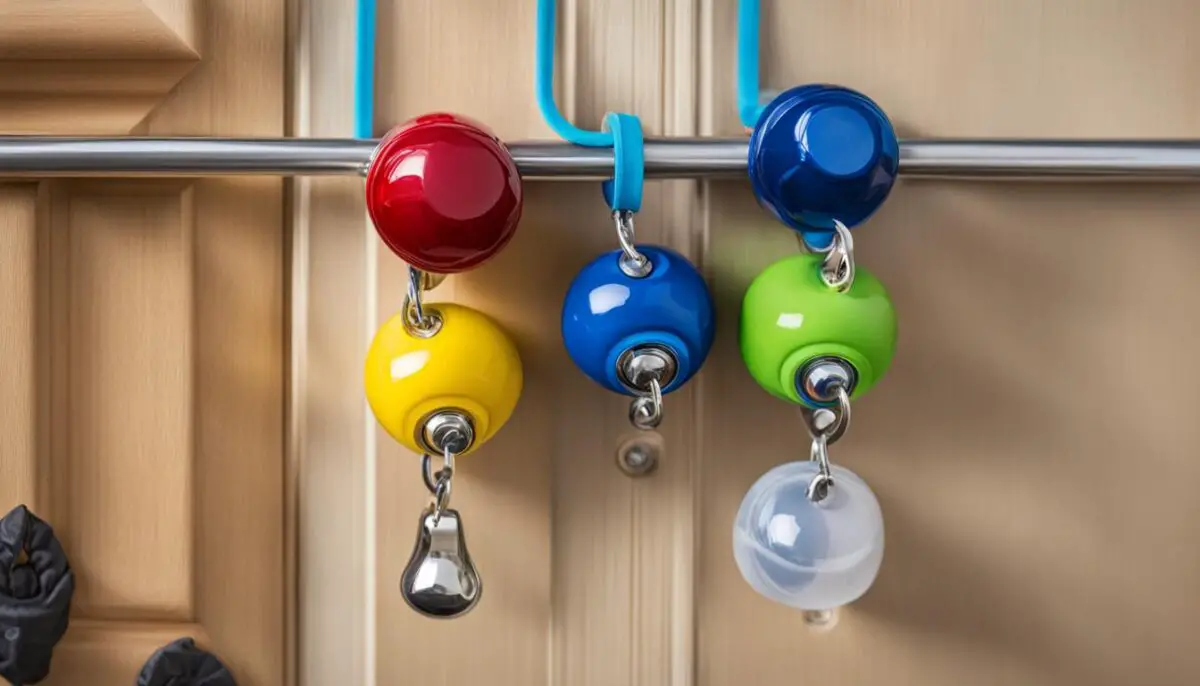Are you struggling with housebreaking your dog? Potty bell training may be the solution you’ve been looking for. This simple yet effective method involves using a bell that your dog can ring to signal when they need to go potty. Not only does it help establish clear communication between you and your furry friend, but it also prevents accidents indoors.
Key Takeaways:
- Potty bell training is an effective method for housebreaking dogs.
- Dogs can be taught to ring a bell to signal when they need to go outside to potty.
- Adjustable hanging potty bells or courtesy desk potty bells can be used as training tools.
- Consistency and positive reinforcement are key to successful potty bell training.
- Following a potty schedule and understanding your puppy’s needs can contribute to the training’s success.
What Are Potty Bells and How Do They Work?
Potty bells are a housetraining tool that serves as a signal for your dog to indicate their need to go potty. These innovative bells can be hung on the door or placed on the floor near the exit, making them easily accessible for your furry friend. When your dog wants to go outside, they can tap the bell with their paw or nose to alert you.
The sound of the bell helps establish an association between ringing the bell and going outside to potty. This means that every time your dog rings the bell, you know they need to go outside for a bathroom break. Utilizing potty bells in your training routine can significantly improve communication between you and your dog, ultimately helping to prevent accidents indoors.
There are different types of potty bells available:
- Service desk or courtesy bells: These are similar to the bells you might find at a hotel front desk. They can be rung with a gentle tap and produce a clear sound.
- Hanging dog bells with adjustable straps: These bells come with adjustable straps that can be easily attached to the doorknob or handle. This allows you to adjust the height for your dog’s comfort.
- Wall-mounted bells: These bells are designed to be mounted on the wall near the exit. They provide a fixed location for your dog to reach and ring the bell.
Adjusting the height and location of the bell is essential to ensure your dog can reach it comfortably. It’s important to find the right balance so that the bell is accessible without being too low or too high for your dog to reach.

How to Use Potty Bells for Training
Using potty bells for training is a simple and effective method to teach your dog how to communicate their need to go potty. Whether you’re using adjustable hanging potty bells or courtesy desk potty bells, the process remains consistent. Let’s explore the step-by-step guide on how to use potty bells for training.
Adjustable Hanging Potty Bells
If you have adjustable hanging potty bells, follow these steps:
- Hang the potty bells next to or near the door you want your dog to use for potty breaks. The bells should be within your dog’s reach.
- Adjust the strap length so that the bottom bells are easily accessible for your dog.
- Take a treat in your hand and demonstrate ringing the bells yourself. Say a command like “Go potty” while ringing the bells.
- Lead your dog towards the bells and encourage them to touch or ring the bells with their nose or paw.
- Praise and reward your dog with a treat immediately after they interact with the bells.
- Open the door and take your dog outside to their designated potty area. Encourage them to relieve themselves.
- Repeat this process consistently for about a week to establish the association between ringing the bell and going outside to potty.
- Be patient and consistent with the training, reinforcing positive behavior with rewards and praise.
Courtesy Desk Potty Bells
If you’re using courtesy desk potty bells, here’s how to use them:
- Place the courtesy desk potty bells on the floor near the door you want your dog to use for potty breaks.
- Ensure the bells are easily accessible for your dog to interact with.
- Follow the same process of demonstrating and encouraging your dog to ring the bells with their nose or paw.
- Reward and praise your dog each time they interact with the bells as desired.
- Take your dog outside to their designated potty area shortly after they ring the bells.
- Continue to repeat this process consistently, reinforcing positive behavior and associating the bell ringing with going outside to potty.
Incorporating potty bells into your training routine allows your dog to communicate their needs effectively. The sound of the bell becomes a clear signal for you to open the door and let them outside for a potty break.

| Adjustable Hanging Potty Bells | Courtesy Desk Potty Bells |
|---|---|
| Hang next to or near the door | Place on the floor near the door |
| Adjust strap length to dog’s reach | Easily accessible for your dog |
| Teach your dog to ring the bells | Demonstrate and encourage interaction |
| Take dog outside immediately after | Take dog outside immediately after |
| Consistency and rewards are key | Consistency and rewards are key |
Steps to Train Your Dog Using Potty Bells
Training your dog to use potty bells can be broken down into three simple steps:
- Step 1: Set up the bells
First, buy a set of potty training bells and hang them at your dog’s level on the wall next to the main door. This makes it easy for your dog to reach and use the bells whenever they need to go potty.
- Step 2: Introduce the bells and reinforce the behavior
Before heading outside, you need to familiarize your dog with the bells and teach them the purpose of ringing them. To do this, ring the bells yourself and say a command like “Go potty.” Take your dog out on a leash to the designated potty spot, and when they do their business, reward them with praise and treats. This positive reinforcement helps your dog understand that ringing the bells leads to going outside to potty.
Expert Tip: Luring your dog to ring the bell by showing them a treat and leading them to the bells can fast-track the training process.
- Step 3: Phasing out the food lure
Once your dog grasps the concept of ringing the bell to signal their need to go outside, you can phase out the food lure. Instead of showing them a treat to lead them to the bells, use a hand gesture to signal the dog to ring the bell. Continue rewarding them with praise and treats for ringing the bell and taking them outside for potty breaks. With consistent practice, your dog will learn to associate the bell with going outdoors to relieve themselves.
Remember, patience and consistency are key when training your dog to use potty bells. Celebrate their successes and continue reinforcing the behavior until it becomes a natural part of their routine.

Frequency of Potty Breaks for Puppies
Puppies have smaller bladders and less control over their bladder functions, so they need frequent potty breaks. It’s essential to establish a consistent potty schedule to help with puppy potty training and bladder control. In general, puppies should be taken outside to potty every 2 to 4 hours.
The American Kennel Club (AKC) recommends using a “month-plus-one” rule to determine the maximum number of hours a puppy can wait to potty. For example, if you have a 2-month-old puppy, they should go potty at least every 3 hours.
Additionally, puppies should be taken outside to potty within 30 minutes of the following activities:
- Eating
- Waking up from a nap
- Engaging in physical activity
By observing your puppy’s individual needs and following a consistent potty schedule, you can help them develop proper bladder control and establish good bathroom habits.
Here is an example of a potty schedule for a 2-month-old puppy:
| Time | Description |
|---|---|
| 7:00 AM | First potty break in the morning |
| 7:30 AM | Mealtime |
| 8:00 AM | Potty break |
| 10:00 AM | Potty break |
| 12:00 PM | Potty break |
| 2:00 PM | Potty break |
| 4:00 PM | Potty break |
| 6:00 PM | Potty break |
| 8:00 PM | Potty break |
| 10:00 PM | Last potty break before bedtime |
Remember, each puppy is unique, so you may need to adjust the schedule based on your puppy’s specific needs and bladder control development.
Note: The above table is for illustrative purposes only. Please customize the potty schedule to fit your puppy’s needs and consult with a veterinarian for personalized advice.
Tips and Considerations for Potty Bell Training
When potty bell training your dog, it’s important to use positive reinforcement and avoid punishment. Working with a professional dog trainer can provide additional guidance and enhance training success. The training process may take several months, and adult dogs may take longer if they have previous bad habits. Smaller dogs may find it more challenging to understand the concept of potty training, so extra patience and consistency are necessary. If you live in an apartment or townhouse, you can combine potty bell training with alternative methods to accommodate the dog’s needs when you’re not at home. The key to success is consistency and establishing a strong association between ringing the bell and going outside to potty.
Having a visual cue like a potty bell can be extremely helpful in potty training your dog. However, it’s important to remember that every dog is different, and the training process may vary. Here are some tips and considerations to keep in mind:
1. Start with Basic Commands
Before introducing the potty bell, make sure your dog is familiar with basic commands such as “sit,” “stay,” and “come.” This foundation will make it easier for them to understand and follow the potty bell training.
2. Choose a Clear Signal
Decide on a specific signal that your dog can easily understand, such as a bell or a set of bells hung by the door. Consistently use this signal every time you take your dog outside to potty, reinforcing the association between the signal and the potty break.
3. Use Positive Reinforcement
Positive reinforcement is the key to successful potty bell training. Whenever your dog rings the bell and goes outside to potty, reward them with praise, treats, or their favorite toy. This positive reinforcement will motivate your dog to repeat the behavior.
4. Be Patient and Consistent
Potty bell training takes time and patience. Your dog may not grasp the concept immediately, so stay consistent and reinforce the training every time. Avoid scolding or punishing your dog if accidents happen, as this can create a negative association with the bell.
“Consistency is key in potty bell training. By using positive reinforcement and maintaining a regular routine, you can help your dog understand and communicate their potty needs effectively.” – Dr. Emily Wilson
5. Adjust the Training to Your Dog’s Needs
Each dog is unique, so adjust the training methods to suit your dog’s individual needs. Pay attention to their body language and behavior, as some dogs may have subtle signs indicating they need to go potty. Adapt the training accordingly for the best results.
| Tip | Explanation |
|---|---|
| Establish a Routine | Set a consistent schedule for potty breaks, ensuring your dog goes out to potty at regular intervals throughout the day. |
| Remove Confusion | Limit access to areas where accidents may occur to prevent confusion and reinforce the proper potty location. |
| Monitor Water Intake | Keep track of your dog’s water intake, especially before bedtime, to anticipate their potty needs. |
Potty bell training requires time, patience, and consistency. By following these tips and considering your dog’s individual needs, you can successfully train them to use the potty bell and effectively communicate their need to go outside to potty.
Conclusion
Potty bell training is a highly effective method for housebreaking dogs and establishing clear communication between you and your furry friend. By using tools such as adjustable hanging potty bells or courtesy desk potty bells, and consistently following a training routine, you can successfully teach your dog to signal when they need to go potty.
During the training process, it is essential to rely on positive reinforcement, rewarding your dog for using the potty bell correctly. Additionally, establishing a potty schedule and being patient with your dog’s learning curve will contribute to a smoother housebreaking experience.
Potty bell training is a valuable tool that can make the entire housebreaking process easier and prevent accidents from occurring indoors. Through consistency, positive reinforcement, and clear communication, you can successfully train your dog to use the potty bell and enjoy a well-housebroken pet.
FAQ
What is potty bell training?
Potty bell training is a method used to housebreak dogs by teaching them to ring a bell to signal when they need to go potty.
How do potty bells work?
Potty bells are hung on the door or placed on the floor near the exit. When a dog needs to go outside, they can tap the bell with their paw or nose to alert their owner.
What types of potty bells are available?
There are different types of potty bells, including service desk or courtesy bells, hanging dog bells with adjustable straps, and wall-mounted bells.
How do I use potty bells for training?
To use potty bells for training, you should hang them next to or near the door your dog will use for potty breaks. Teach your dog to ring the bells by demonstrating it with a treat and a command before taking them outside.
What are the steps to train a dog using potty bells?
The steps to train a dog using potty bells include hanging the bells at the dog’s level, using treats and commands to teach them to ring the bells, and gradually phasing out food lures and using hand gestures instead.
How often do puppies need potty breaks?
Puppies generally need to go potty every 2 to 4 hours. Following a consistent potty schedule and paying attention to individual needs is important for successful potty training.
What tips and considerations should I keep in mind for potty bell training?
It’s important to use positive reinforcement and avoid punishment when potty bell training. Consistency and establishing a strong association between ringing the bell and going outside to potty are key. Working with a professional dog trainer can provide additional guidance.
Why is potty bell training an effective method for housebreaking dogs?
Potty bell training helps establish clear communication between dog owners and their pets, preventing accidents indoors. It provides a reliable way for dogs to signal their need to go outside to potty.

